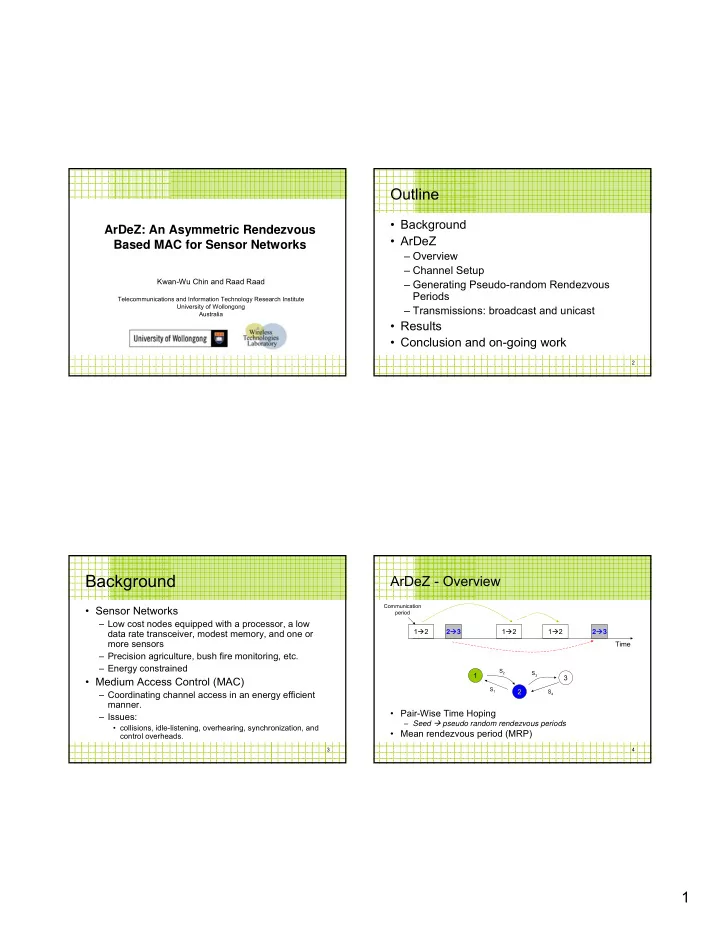

Outline • Background ArDeZ: An Asymmetric Rendezvous • ArDeZ Based MAC for Sensor Networks – Overview – Channel Setup Kwan-Wu Chin and Raad Raad – Generating Pseudo-random Rendezvous Periods Telecommunications and Information Technology Research Institute University of Wollongong – Transmissions: broadcast and unicast Australia • Results • Conclusion and on-going work 2 Background ArDeZ - Overview Communication • Sensor Networks period – Low cost nodes equipped with a processor, a low 1 � 2 2 � 3 1 � 2 1 � 2 2 � 3 data rate transceiver, modest memory, and one or more sensors Time – Precision agriculture, bush fire monitoring, etc. – Energy constrained S 2 S 3 1 3 • Medium Access Control (MAC) S 1 2 S 4 – Coordinating channel access in an energy efficient manner. • Pair-Wise Time Hoping – Issues: – Seed � pseudo random rendezvous periods • collisions, idle-listening, overhearing, synchronization, and • Mean rendezvous period (MRP) control overheads. 3 4 1
ArDeZ – Channel Setup ArDeZ – Channel Setup Part 1 Part II • Invite message • Node address Sleep – Frequency dictated by Invite’s Mean Time • Sensor capabilities Rendezvous Period (MRP) Node-A’s • Uplink and Downlink seeds � U s and D s Invite Message • Scan for a maximum WaitNeighbor time • Constants C a and C b • Upon receiving an Invite message, a sensor selects an invite slot randomly. (Inviter) (Invitee) Node-A Node-B Invite Message Channel Request Message Neighbors == N ? Channel exist with node-A? (S u , S d , Duration) Node-A meets criteria? Sleep Channel ACK Message (CAM) Time Invite Slots 5 6 ArDeZ – Generation Rendezvous Periods ArDeZ – Generation Rendezvous Periods = i U S Advertise in Invite seed u = + wake Messages, and Uplink ( IM U ) IM rx is the timestamp = i i rx i D S selected by an seed d of the Invite Message = + wake invitee Downlink ( IM D ) i rx i = + i i S ( C U C )% 255 u a seed b + C a and C b are = i 1 i U S = + constants i i seed u Update the seed for S ( C D C )% 255 d a seed b next iteration + = i 1 i D S seed d i S = × wake Jump offset U u MRP i • First rendezvous period is relative to the reception time of the Invite 255 MRP controls how Message. Subsequent periods are relative to the last rendezvous i “far” we jump into the S = × wake d period’s end time. D MRP future i 255 7 8 2
ArDeZ – Supporting Broadcast ArDeZ – Transmitting and Receiving Frame DATA/ACK B 2 – Broadcast seed. Hdr Sender Time S 2 S 4 1 Wakeup 1 3 3 S 1 2 S 3 B 2 2 B 2 Frame DATA/ACK Hdr S 6 Receiver S 5 B 2 Time 4 Wakeup MaxWait 4 • MaxWait – minimize idle listening Node-2 transmits, all other neighbors listen. • Send a packet every z rendezvous periods to avoid losing synchronization 9 10 Analysis – Overlapping periods Analysis – Channel Setup 8-bit 16-bit 11 12 3
Simulation Results – Channel Setup • ns-2 (ns-allinone-2.1b9) • CBR – 100 packets, 50 bytes • Only establish channels to a neighbor that has a path to the sink • Data rate – 20 Kb/s • Rendezvous period length, 30ms • Random number range, 0 … 255 • Energy – Tx (12 mAh), Rx (1.8 mAh), asleep (5 μ Ah) 13 14 Results – Node Density vs. Packet Results – Network Setup Time (36 nodes) Delivery Ratio 15 16 4
Results – Throughput vs. Network Sizes Results – Energy Drain vs MRP 8-months 17 18 Conclusion Current Work • ArDeZ – An asymmetric MAC that uses • Comparisons with other MACs pseudo-random sleep/wake periods. – SMAC, TRAMA, WiseMAC, etc… – Uplink and downlink channels with different • Design and implementation of routing and duty cycles transport protocols that make use of MRP • Simple setup procedure • Collision free extensions – Low signaling overheads – Listening to neighbors’ seeds • No global synchronization or superframe • Duty Cycle controlled by adjusting each link’s Mean Rendezvous Period (MRP) 19 20 5
Questions? kwanwu@uow.edu.au 21 6
Recommend
More recommend